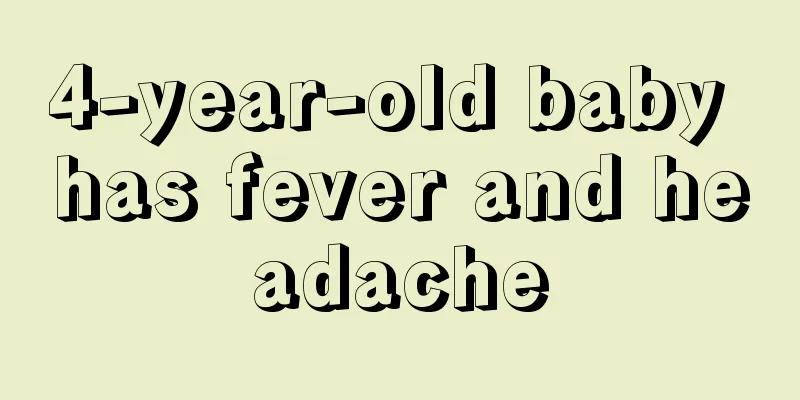4-year-old baby has fever and headache

|
The body resistance of babies is naturally much worse than that of adults, so children's colds are generally accompanied by severe fevers. Fever for a long time is easy to cause pneumonia or encephalitis. Therefore, parents must pay attention to the baby's fever. If the baby has a fever and headache, the baby should be given a fever-reducing injection in time, and the baby's condition and body temperature should be observed at all times. So what should I do if a 4-year-old baby has a fever and headache? A baby's fever usually does not damage the brain. Fever is a positive sign that the body is fighting infection, which helps to eliminate pathogens and promote recovery from the disease. Unless the fever is extremely high, exceeding 41°C or caused by intracranial infection, infants under three months old with a body temperature exceeding 38°C need to seek medical attention as soon as possible, otherwise it can easily cause brain damage. However, older children will not become stupid due to the fever. Since the sweat glands of babies under three months old are underdeveloped, you must not cover your baby when he or she has a fever and you must replenish your baby with water in time. In addition, when the baby is not feeling unwell or having convulsions and the body temperature is not higher than 38.5℃, there is no need for antipyretics. What parents need to do is to encourage their babies to drink more water and avoid eating greasy and indigestible foods. At the same time, physical cooling methods can be used to reduce the baby's fever. What to do if your baby has a fever 1. Physical cooling ① Use "loose bag cooling" for newborns Parents can open the blankets and loosen the clothes. They can also feed the baby more warm water or bathe him with warm water. It is prohibited to use ice packs or alcohol wipes. ② Warm water compress and warm water bath are the first choice for children under 2 years old (also suitable for children of other ages) Warm and wet compress: Soak a towel in warm water at about 35°C, take it out and wring out the water, apply it to the child's forehead, and change it every 10-15 minutes. Warm water bath: The water temperature should be close to body temperature (test on the wrist to make sure it is not hot), and it can be used from the limbs to the whole body. Sponge bathing can dilate blood vessels in the skin and increase blood flow, thus achieving the purpose of heat dissipation, and the child will also feel comfortable. It is convenient, economical, effective and non-hazardous. It is not advisable to use cold water baths, as cold water will cause the child's blood vessels to constrict, which is not conducive to physical cooling and will cause obvious discomfort. ③ Children over 2 years old can use alcohol bath Dip gauze in 30%-50% warm alcohol (the disinfectant alcohol sold on the market is 75% and needs to be diluted with an equal volume of warm water), and wipe the areas with rich blood vessels from top to bottom (neck, armpits, elbows, groin, palms, and soles of feet) to achieve the purpose of evaporation and cooling. When giving a sponge bath, avoid the chest and back of the child, observe changes in facial color, and measure body temperature every 30 minutes to prevent cold and excessive cooling. |
<<: How to wean a one and a half year old baby
Recommend
What are the symptoms of diarrhea in babies?
When infants and young children fall ill, parents...
How to determine phimosis in children?
Many parents will find that most children are bor...
What to do if a newborn baby has inflammation
Newborns are prone to respiratory infections, whi...
What to do if your baby has a fever and is afraid of cold
If you have a fever as an adult, you may be able ...
What to do if your baby has a cold and has thick yellow nasal discharge
In real life, babies have poor resistance to viru...
How to improve children's memory
Children will encounter many problems during thei...
What should I do if my baby has a low fever of 38 degrees?
When the baby has a low fever of 38 degrees, the ...
If your baby doesn't absorb the milk powder, add more trace elements!
When babies reach a certain age, they need to rel...
What to do if your child has a fever and refuses to take medicine
Babies always have a poor appetite and refuse to ...
What to do if your child's ears itch
When the sensory nerve endings in the skin of the...
How long does it take for an ulna fracture to heal?
My child is five years old this year. Some time a...
Why do babies like to shake their heads?
Shaking the head is a condition that many people ...
What should children eat to be good for their eyes? Eat more fish and vitamins
Children's myopia has become more and more se...
Why are the inner lips of the baby white?
When the baby's body shows abnormal phenomena...
What to do if baby has red pimples on face
There are many reasons that can cause small red p...









